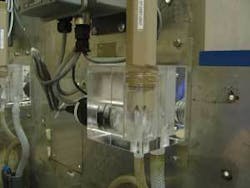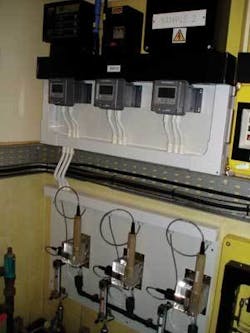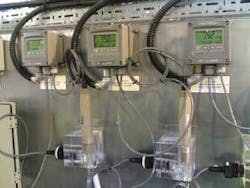The Changing Technology of monitoring chlorine levels
Polarographic membraned probes help better manage effects of fouling without need for electrode cleaning systems. The novel technology allows for continuous chlorine measurement at high stable pH without use of chemical buffers.
The quality of global drinking water in the United Kingdom is controlled by law under terms of the “Water Supply (Water Quality) Regulations 1989”. To comply with these strict regulations, the water industry carries out thousands of its own water quality tests every day and reports failures to the appropriate body. From 1989 to 2005, over £50 billion has been invested in improving drinking water quality and higher environmental standards in the UK. Chlorine monitoring is one of the most important analyses that need to be conducted during the water treatment process. New technologies coming onto the market have improved performance of monitoring systems and reduced or eliminated the need for reagents.
Chlorine monitoring
Chlorine, available as gas, liquid or solid, is the most widespread disinfectant used for the treatment of drinking and cooling water systems. It’s added at water treatment plants to destroy contaminants, disinfect drinking water and minimize microbial growth in distribution networks. Monitoring chlorine levels in drinking water entering a distribution system is normally considered a high priority, because the monitoring is used as an indicator disinfection has taken place and there’s no excessive chlorine present in the water supply. According to the “Guidelines for drinking-water quality” (WHO 2004), maintaining a free residual chlorine level of 0.2-0.5 mg/L in the water throughout the distribution system is desirable.
Surveillance of treated water for chlorine residual is necessary to properly regulate the chlorination process, for all communities regardless of population size. Both free and total chlorine residual monitoring is necessary to get a complete picture. Chorine residual monitoring is required for systems supplying water for human consumptive use and those hygienic use systems where disinfection is performed in accordance with permit requirements. Chlorine residual determinations must be conducted onsite.
It’s also important to monitor and control the chlorine levels in cooling water systems, which utilize oxidizing biocides such as chlorine, chlorine/bromine, or sodium hypochlorite. If a true chlorine residual is not maintained, biological deposition and/or under deposit corrosion will occur. In cases where chlorine residuals are too high, corrosion will occur.
For many applications, process pH is relatively stable meaning nothing more than a standard monitor and sensor are needed. When the pH of the water stream varies regularly, however, a significant error in free chlorine concentration is introduced. This error is due to the sensor’s sensitivity to wide pH fluctuations. High pH values cause loss of sensitivity in free chlorine monitors. In general, free chlorine sensors will work well as long as the pH of the sample water remains below pH 8.0 and is stable. Should the pH of the sample run consistently higher than 8.0 or fluctuate, though, an acidic buffer is necessary to reduce the sample pH.
As the water industry matures, greater scrutiny is placed on the true cost of operating monitors over the lifetime of service. With open cell design, those with amperometric designs suffer from high levels of component failure, with pumps, for example, prone to fouling by waterborne contaminants, such as iron and magnesium, or from added chemicals, such as ortho-phospheric acid. Fouling leads to inaccurate readings and zero drift.
Recent industry data estimates the monthly cost of operating one amperometric monitor with buffer at £60 per month. The reagents need periodic replenishment and the delivery systems need regular maintenance. The total cost of running a buffered amperometric monitor can approach £1.000 per year. There are tens of thousands of residual chlorine monitors installed in the UK and it’s estimated the current cost of running buffered amperometric monitors to the UK industry could exceed £20 million per year. It’s therefore no surprise many leading water companies are now looking into using new technologies for chlorine monitoring.
Alternative Buffers
Water companies are now researching alternatives to buffers for a number of reasons, with the high total cost and associated maintenance and service being the principal driver. Buffers also present an environmental problem, with water companies facing the difficulty of disposing of buffered samples correctly. In areas such as the Scottish Highlands, there’s no economically viable way of safely disposing of buffered samples, a chemical drain isn’t available and the cost of hauling or tankering away waste would be prohibitively high.
In response to this, many water companies have experimented with CO2, which acts in a similar way to the acid buffer. It reduces and stabilizes pH to less than 6.0. The historical downside of CO2 is, although very effective, it’s difficult to deliver the CO2 into the water sample efficiently. Following an in-house development of a delivery system, South West Water has introduced CO2 buffering on all of its major works. There are two main drivers behind this bold move: cost reduction and environmental benefits. CO2 buffering costs are around 10% of liquid buffering and a CO2 buffered sample can be disposed of via a normal drain, whereas a sample containing liquid buffers must be disposed of in chemical drains or tankered offsite.
Alternative Technologies
Due to pressure from within the water industry, most major manufacturers of chlorine monitors now offer new technology that integrates the signal from a pH sensor to correct the chlorine signal as required. When originally introduced, these devices weren’t as successful as initially hoped. For example, the pH range in which the monitors worked was limited and there were issues with response times.
Polarographic membraned probes have gained increasing use in the industry over the past 15 years. Polarographic membraned cells are a closed cell amperometric device. The membrane helps better manage effects of fouling, for example, without need for an electrode cleaning systems. When designed correctly, the technology allows for continuous measurement of chlorine at high stable pH without use of chemical buffers. If the correct sensor is used, there’s an extended response to chlorine at high pH levels, allowing pH correction to be employed over a much wider range.
More recently, some pH corrected membrane monitors are proving as stable and accurate as traditionally buffered monitors, thus offering the water industry a new way forward. As a result of a number of industry evaluations, these monitors are fast becoming the preferred instrument of choice.
New System
In response to the emerging need for new technologies, Analytical Technology Inc. (ATi) has launched a new instrument for on-line monitoring and control of chlorination systems. Model Q45H is available in two versions: a free chlorine monitor for drinking and cooling water systems and a combined chlorine monitor suited for chloraminated drinking water. The combined chlorine system can also be used in wastewater effluents where sufficient ammonia is present prior to chlorination to result in a predominantly monochloramine residual.
The free chlorine Q45H62 uses a membrane-covered polarographic sensor that doesn’t require addition of chemical reagents over a pH range that covers the vast majority of drinking water applications. In variable pH applications, it uses an optional pH compensation feature to eliminate free chlorine error caused by process pH drift.
Unlike on-line colorimetric and most amperometric monitors, the Q45H utilizes a membrane-covered polarographic sensor with an enhanced response at high pH that doesn’t require chemical reagents. The membrane also protects the measuring electrodes and eliminates the need for electrode cleaning systems.
The instrument is available in loop powered and mains powered versions, and can be supplied battery powered with an internal data-logger, making it ideal for short term monitoring at remote sites. The unit will run for 10 days on a single battery and the data-logger will store up to 32,000 data points at one-minute intervals.
Conclusion
In order to exploit future growth opportunities and stay ahead of competition, water and wastewater treatment companies need to be able to invest in further research and develop new chlorine monitoring technologies. As the water industry is looking to eliminate the use of buffer reagents, most manufacturers are now offering reagent free chlorine monitors. Whereas some companies have chosen to use CO2 monitors as a less expensive “green” option, the ever-increasing improvements in chlorine monitor technology means the need for buffer is a thing of the past.
About the Author:
John Becker is president of Analytical Technology Inc., based in Collegeville, Pennsylvania, USA, with European offices in Mossley, Ashton-u-Lyne, England. He has over 25 years of experience with on-line analyzers and their application to the water and wastewater industry. Contact: www.analyticaltechnology.com



